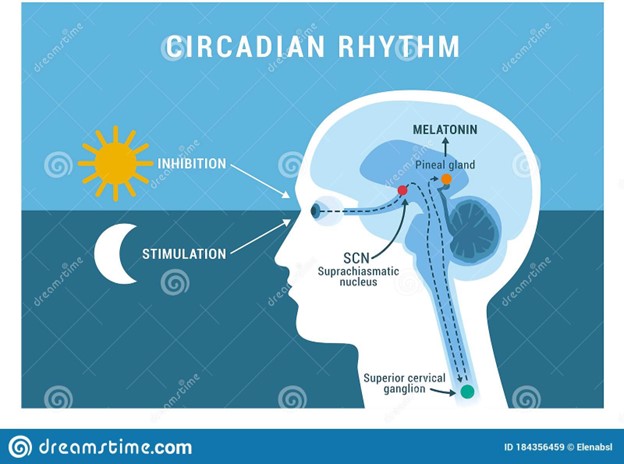A night-shift worker experiences extreme difficulty falling asleep due to being exposed to bright lights during both night and day.
The unusual pattern of light exposure is disturbing which controls the release of the hormone:
Metabolic rate; thyroxine.
Limbic system; thymosin.
Circulatory system; dopamine.
Circadian rhythm; melatonin.
The Correct Answer is D

Circadian rhythm is the term for the biological clock that regulates the sleep-wake cycle and other physiological processes in the body.
Melatonin is a hormone that is produced by the pineal gland in the brain in response to darkness.
It helps with the timing of the circadian rhythm and promotes sleep.
Choice A is wrong because metabolic rate is not affected by light exposure, and thyroxine is a hormone that regulates metabolism, not sleep.
Choice B is wrong because the limbic system is a part of the brain that is involved in emotions, memory, and motivation, not sleep.
Thymosin is a hormone that stimulates the development of T cells, which are part of the immune system.
Choice C is wrong because the circulatory system is the system of blood vessels and organs that transport blood throughout the body, not a part of the brain that controls sleep.
Dopamine is a neurotransmitter that is involved in reward, motivation, and movement, not sleep.
Nursing Test Bank
Naxlex Comprehensive Predictor Exams
Related Questions
Correct Answer is A
Explanation

This is the correct sequence of parts through which blood moves from the vena cava to the lungs.
Choice B is wrong because it reverses the order of the right atrium and right ventricle. Blood flows from the right atrium to the right ventricle, not the other way around.
Choice C is wrong because it switches the positions of the tricuspid valve and the pulmonary valve.
Blood flows from the right atrium through the tricuspid valve to the right ventricle, and then through the pulmonary valve to the pulmonary artery.
Choice D is wrong because it also switches the positions of the tricuspid valve and the pulmonary valve, and reverses the order of the right atrium and right ventricle.
Blood flows from the right atrium through the tricuspid valve to the right ventricle, and then through the pulmonary valve to the pulmonary artery.
The normal range of blood pressure in the vena cava is about 0 to 5 mmHg, while in the pulmonary artery, it is about 15 to 25 mmHg.
The normal range of oxygen saturation in the vena cava is about 60% to 80%, while in the pulmonary vein, it is about 95% to 100%.
Correct Answer is B
Explanation
Circulation is the movement or flow of something, especially blood or air, through a circuit or a specific course.
Circulation supplies oxygen and nutrients to and removes wastes from tissues. This is essential for the survival and functioning of cells and organs.
Choice A is wrong because circulation does not inflate the lungs.
The lungs are inflated by the pressure difference between the air inside and outside the chest cavity.
Choice C is wrong because circulation does not deliver waste to tissues.
Circulation removes wastes from tissues and delivers them to the excretory organs such as the kidneys and the lungs.
Choice D is wrong because circulation does not deliver carbon dioxide to tissues and removes excess oxygen.
Circulation does the opposite: it delivers oxygen to tissues and removes carbon dioxide.
Carbon dioxide is a waste product of cellular respiration that needs to be eliminated from the body.
Whether you are a student looking to ace your exams or a practicing nurse seeking to enhance your expertise , our nursing education contents will empower you with the confidence and competence to make a difference in the lives of patients and become a respected leader in the healthcare field.
Visit Naxlex, invest in your future and unlock endless possibilities with our unparalleled nursing education contents today
Report Wrong Answer on the Current Question
Do you disagree with the answer? If yes, what is your expected answer? Explain.
Kindly be descriptive with the issue you are facing.
